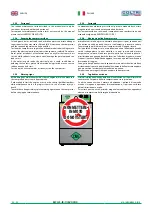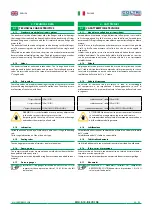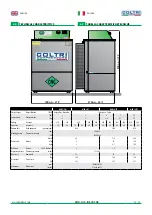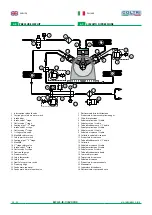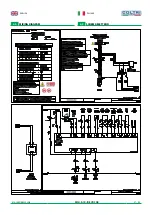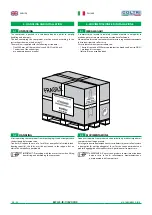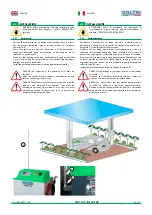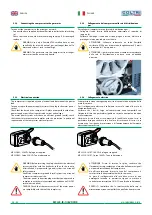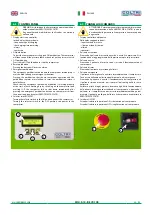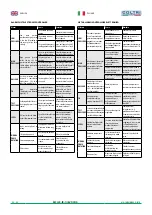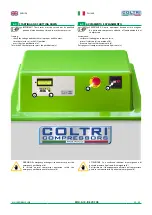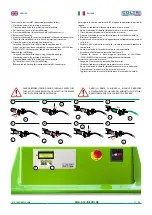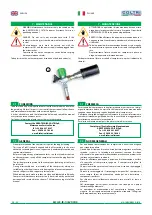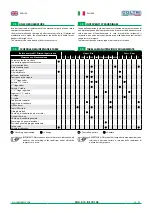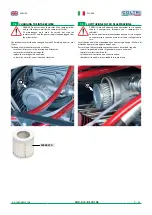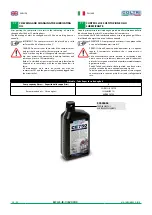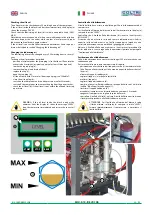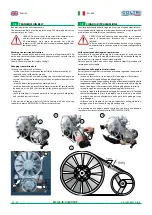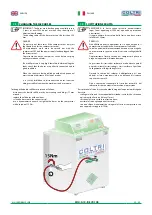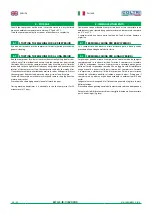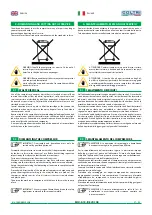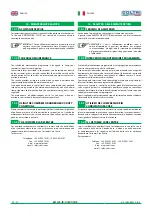
36 - 52
MCH-5-10-14 EVO CNG
MU-CNG51014EVO-1216
START
STOP
RESET
MCH-1
4/ET EV
O
a
TK4
TK4I
TK22
ENGLISH
6.5
REFILL
IMPORTANT: During refill the operator must be in the work
area (a).
Check that the tanks to be refilled are in good condition: they
must have been tested by the relevant authorities (stamped
and/or certified). Run a visual check on the exterior.
Check that the refill hose and relevant fitting are in good
condition.
IMPORTANT: If an emergency situation arises during refill
shut down the compressor immediately (see “6.4 Starting and
shutting down”).
The compressor is nevertheless equipped with a safety
system that shuts it down automatically when:
- A pressure of 200/250bar (2900/3626PSI) has been
reached.
- The electrical power supply is temporarily cut.
- The electric motor overload device is tripped.
Following an emergency shutdown always make sure
the cause of the emergency has been eliminated before
proceeding with another refill.
WARNING: During refill those not involved in the refill
procedure must maintain a safety distance of at least 3
metres. Also, it is forbidden to disconnect the hoses from the
fittings or the fill valve while the machine is under pressure.
WARNING: Use only tested tanks (as proven by a test stamp
and/or certificate).
The working and tank refill pressures are shown on the tanks
themselves.
It is forbidden to refill them at a pressure greater than that
indicated.
DANGER: Should tanks show evident signs of internal/extern
al corrosion, do not refill them even if they have been tested.
DANGER: Gas is highly flammable: it is therefore strictly
forbidden to smoke and/or use naked flames. Use of
equipment that can cause sparks is also strictly forbidden.
Keep the compressor away from heat sources.
The available refill connectors are:
NGV1 Car Connection: International Standard
NGV1 Car Connection: Italy Standard
Fitting for bus and trucks
ITALIANO
6.5
RICARICA
AVVERTENZA: Durante questa operazione l’operatore deve
essere nell’area di lavoro (a).
Verificare le condizioni del serbatoio da riempire: Collaudo
ente autorizzato (stampigliatura e/o certificato).
Controllo visivo esterno
Verificare le condizioni delle fruste e dei rispettivi raccordi.
AVVERTENZA: Se durante la ricarica si verificano condizioni di
emergenza, spegnere immediatamente il compressore (vedi
cap. “6.4 Avviamento e spegnimento”).
Il compressore è comunque provvisto di un sistema di
sicurezza che provvede a bloccarlo automaticamente
quando:
- Si è raggiunta la pressione di 200/250bar (2900/3626PSI).
- Vi è una momentanea interruzione della corrente elettrica.
- Scatta lo sgancio termico del motore elettrico per
sovraccarico.
Dopo un arresto di emergenza, prima di procedere ad una
successiva ricarica, è necessario accertarsi che sia stata
eliminata la causa che ha indotto l’emergenza.
ATTENZIONE: Durante la ricarica è obbligatorio, per i non
addetti ai lavori, mantenersi ad una distanza di sicurezza
superiore a 3 metri. Non è consentito, altresì, sconnettere
le fruste dai raccordi o dal rubinetto di ricarica mentre la
macchina è in pressione.
ATTENZIONE: Utilizzare solo serbatoi collaudati e provvisti
della relativa punzonatura e/o certificato di collaudo.
Il valore di pressione d’esercizio e ricarica dei serbatoi è
riportato sugli stessi.
E’ fatto divieto di superare tale valore di pressione di ricarica.
PERICOLO: In caso di serbatoi che presentano evidenti
segni di corrosione interna e/o esterna, si consiglia di non
procedere alla ricarica anche se gli stessi rientrano nei termini
di collaudo.
PERICOLO: Il gas è altamente infiammabile si fa quindi divieto
di fumare e/o usare fiamme libere, è altresì importante non
utilizzare attrezzi in grado di causare scintille.
Tenere il compressore distante da sorgenti di calore.
Gli attacchi disponibili per la ricarica sono:
NGV1 Raccordo per auto: Standard internazionale
NGV1 Raccordo per auto: Standard Italia
Raccordo per autobus e camion

